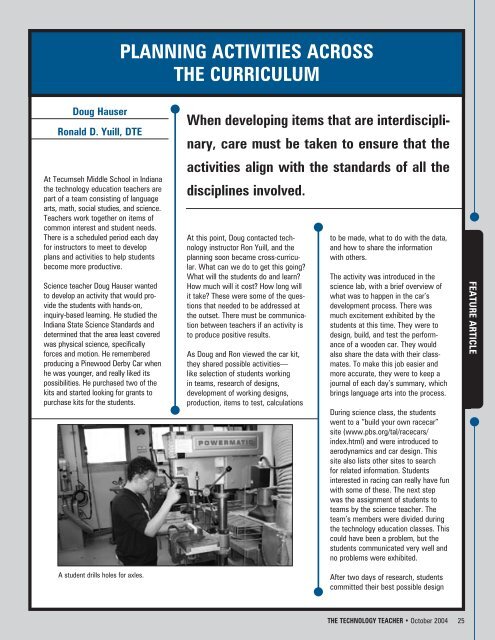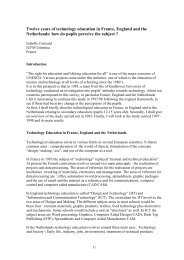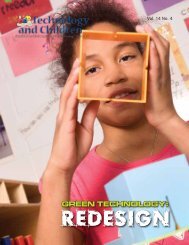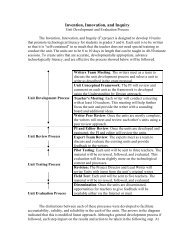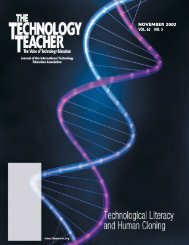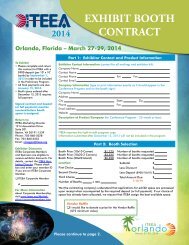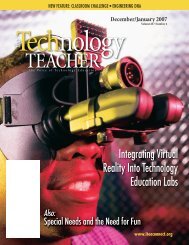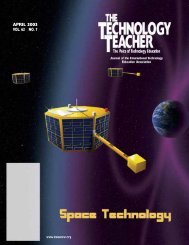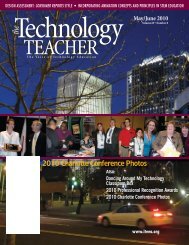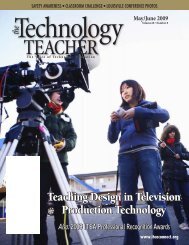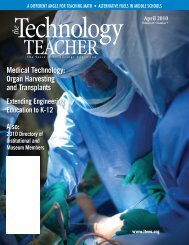RESOURCES IN TECHNOLOGYcosts of renewable <strong>and</strong> advanced fossilfuel technologies as each competeswith the other. Currently, nuclearpower is most suitable for electricityproduction, as are hydro, wind, <strong>and</strong>solar power. However, technologicalprogress is likely to make possible theeventual cost-effective production ofchemical fuels, including hydrogen,from all these sources. They couldthus help meet transportation energyneeds now largely met by oil. Finally,nuclear power might also be extensivelyused in the future for seawaterdesalination, thereby helping toaddress another pressing challenge ofsustainable development—theprovision of plentiful, safe, <strong>and</strong> securesupplies of clean freshwater for agrowing global population (IAEA,<strong>2004</strong>).SummaryThe choice of what type of energytechnologies to use in order to advancesustainable development <strong>and</strong> reduceharmful emissions remains a sovereignchoice of every country. Every countrywill need a mix of energy technologies(hydro, solar, wind, nuclear) that issuited to that country’s geography <strong>and</strong>available resources. Given the advantagesof nuclear power in contributingto sustainable development objectives,it should be an important mix in manycountries. The world will face majorenergy challenges in the twenty-firstcentury, <strong>and</strong> the energy industry willface a future filled with change. Thereare unanswered questions about theevolving competitive environment forelectricity, <strong>and</strong> uncertainty about thefuture price <strong>and</strong> supply of fossil fuels.Questions abound about the economicviability of solar <strong>and</strong> other renewableenergy sources as well as how to managegrowth in electricity dem<strong>and</strong> byincreasing efficiency of use whiledealing with the increasingly stringentenvironmental restrictions on theburning of fossil fuels. The answers tothese questions will require decisionsto be made by an informed <strong>and</strong> educatedpopulace, taking into considerationall social, economic, <strong>and</strong> ethical issuesby examining the balancing of benefits,uncertainties, <strong>and</strong> competing interests.One thing is certain—nuclear energywill play a vital role in the future.Design Brief—The Facts<strong>and</strong> Not the Myths ofNuclear PowerThe development of nuclear power,both fission <strong>and</strong> fusion, has the potentialto meet the world’s energy needsin a responsible manner, promotingconservation of natural resources <strong>and</strong>sustainable economic growth, not onlyin the United States but also on aglobal scale. With carbon emissionsnow threatening the very stability ofthe biosphere, the security of ourworld requires a massive transformationto clean energy. Renewable energysources such as solar, wind, <strong>and</strong>biomass can help, but nuclear energypower has the potential for clean,safe, environmentally friendly energyon a massive scale, <strong>and</strong> it can bemade available to every country in theworld. Unfortunately there are stillmany misconceptions <strong>and</strong> myths surroundingnuclear power.ChallengeThomas Jefferson said, “I know nosafe depository of the ultimate powersof the society but the people themselves;<strong>and</strong> if we think them notenlightened enough to exercise theircontrol with a wholesome discretion,the remedy is not to take it from them,but to inform their discretion.”Your challenge is to create a series ofpublic service announcements to bepublished in a variety of media formats,illuminating the need for arenewable, safe, environmentallybenign energy source that will meetthe world’s growing population needs<strong>and</strong> encourage sustainable growth.Your media campaign can be for anyrenewable energy source for whichyour presentation can be justifiablysupported by your research. You canpresent both negative <strong>and</strong> positiveaspects of the energy solution youhave chosen, but your campaign mustfocus on factual information.ReferencesBeck, P. & Grimston, M. (2002). Double orquits? The global future of civil nuclearenergy. Retrieved June 14, <strong>2004</strong>, fromwww.riia.org/pdf/research/sdp/Nuclear_Double_or_Quits.pdf<strong>International</strong> Atomic Energy Agency(IAEA). (<strong>2004</strong>). Focus on sustainabledevelopment. Retrieved June 15, <strong>2004</strong>,from www.iaea.org/Publications/Factsheets/English/sustaindev-e.pdf<strong>International</strong> Atomic Energy Agency(IAEA). (<strong>2004</strong>). Nuclear power’schanging future. Retrieved July 26,<strong>2004</strong>, from www.iaea.org/NewsCenter/PressReleases/<strong>2004</strong>/prn<strong>2004</strong>05.html<strong>International</strong> <strong>Technology</strong> EducationAssociation (ITEA). (2000, 2002).St<strong>and</strong>ards for technological literacy:Content for the study of technology.Reston, VA: Author.Nuclear Energy Institute (NEI). (<strong>2004</strong>).Nuclear facts. Retrieved August 5,<strong>2004</strong>, from www.nei.org/doc.asp?catnum=2&catid=106Perera, J. (<strong>2004</strong>). Fuelling innovation,countries look to the next generation ofnuclear power. Retrieved July 30, <strong>2004</strong>,from www.iaea.org/Publications/Magazines/Bulletin/Bull461/article15.pdfUnited States Census Bureau (<strong>2004</strong>).Global population at a glance.Retrieved July 17, <strong>2004</strong>, fromwww.census.gov/ipc/prod/wp02/wp02-1.pdfWorld Nuclear Association (<strong>2004</strong>). ForSustainable strategy, indispensablenuclear energy. Retrieved July 28,<strong>2004</strong>, from www.world-nuclear.org/sustdev/one_page_flyer/index.htmStephen L. Baird is atechnology educationteacher at BaysideMiddle School,Virginia Beach,Virginia <strong>and</strong> adjunctfaculty member atOld DominionUniversity. He can be reached viae-mail at slbaird@vbschools.com24 <strong>October</strong> <strong>2004</strong> • THE TECHNOLOGY TEACHER
PLANNING ACTIVITIES ACROSSTHE CURRICULUMDoug HauserRonald D. Yuill, DTEAt Tecumseh Middle School in Indianathe technology education teachers arepart of a team consisting of languagearts, math, social studies, <strong>and</strong> science.Teachers work together on items ofcommon interest <strong>and</strong> student needs.There is a scheduled period each dayfor instructors to meet to developplans <strong>and</strong> activities to help studentsbecome more productive.Science teacher Doug Hauser wantedto develop an activity that would providethe students with h<strong>and</strong>s-on,inquiry-based learning. He studied theIndiana State Science St<strong>and</strong>ards <strong>and</strong>determined that the area least coveredwas physical science, specificallyforces <strong>and</strong> motion. He rememberedproducing a Pinewood Derby Car whenhe was younger, <strong>and</strong> really liked itspossibilities. He purchased two of thekits <strong>and</strong> started looking for grants topurchase kits for the students.A student drills holes for axles.When developing items that are interdisciplinary,care must be taken to ensure that theactivities align with the st<strong>and</strong>ards of all thedisciplines involved.At this point, Doug contacted technologyinstructor Ron Yuill, <strong>and</strong> theplanning soon became cross-curricular.What can we do to get this going?What will the students do <strong>and</strong> learn?How much will it cost? How long willit take? These were some of the questionsthat needed to be addressed atthe outset. There must be communicationbetween teachers if an activity isto produce positive results.As Doug <strong>and</strong> Ron viewed the car kit,they shared possible activities—like selection of students workingin teams, research of designs,development of working designs,production, items to test, calculationsto be made, what to do with the data,<strong>and</strong> how to share the informationwith others.The activity was introduced in thescience lab, with a brief overview ofwhat was to happen in the car’sdevelopment process. There wasmuch excitement exhibited by thestudents at this time. They were todesign, build, <strong>and</strong> test the performanceof a wooden car. They wouldalso share the data with their classmates.To make this job easier <strong>and</strong>more accurate, they were to keep ajournal of each day’s summary, whichbrings language arts into the process.During science class, the studentswent to a “build your own racecar”site (www.pbs.org/tal/racecars/index.html) <strong>and</strong> were introduced toaerodynamics <strong>and</strong> car design. Thissite also lists other sites to searchfor related information. Studentsinterested in racing can really have funwith some of these. The next stepwas the assignment of students toteams by the science teacher. Theteam’s members were divided duringthe technology education classes. Thiscould have been a problem, but thestudents communicated very well <strong>and</strong>no problems were exhibited.After two days of research, studentscommitted their best possible designFEATURE ARTICLETHE TECHNOLOGY TEACHER • <strong>October</strong> <strong>2004</strong> 25


